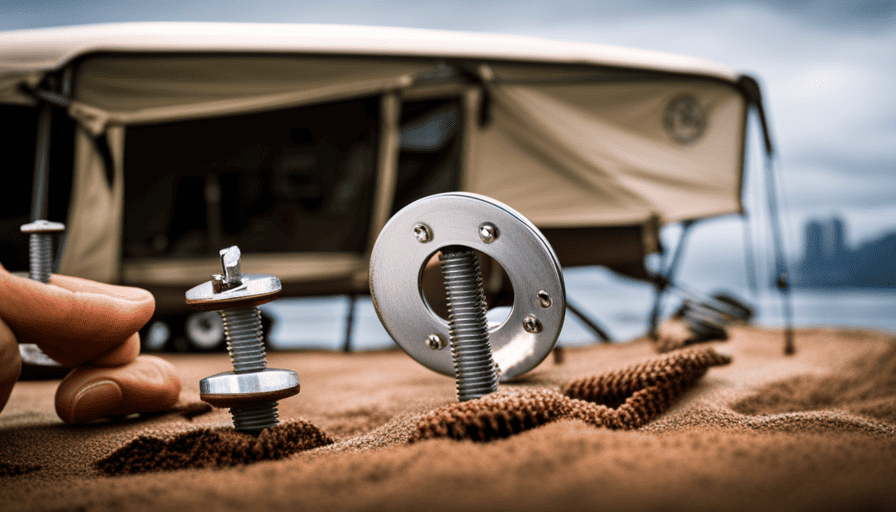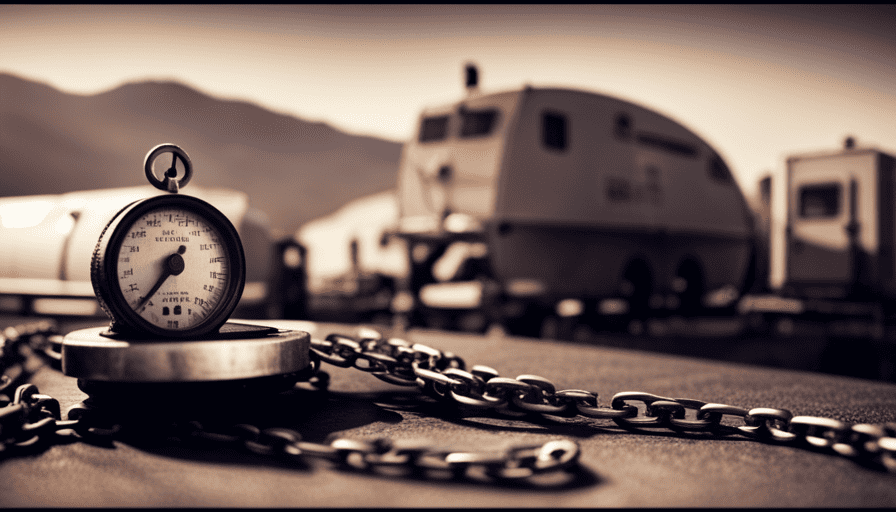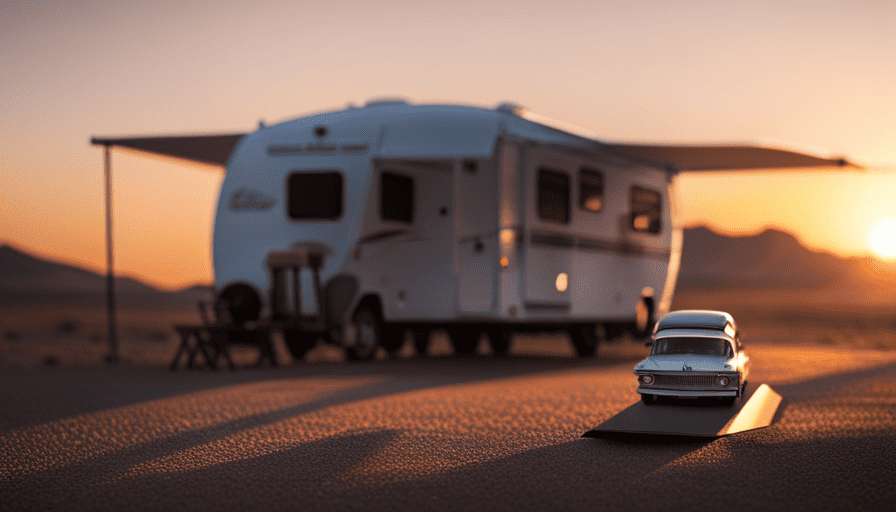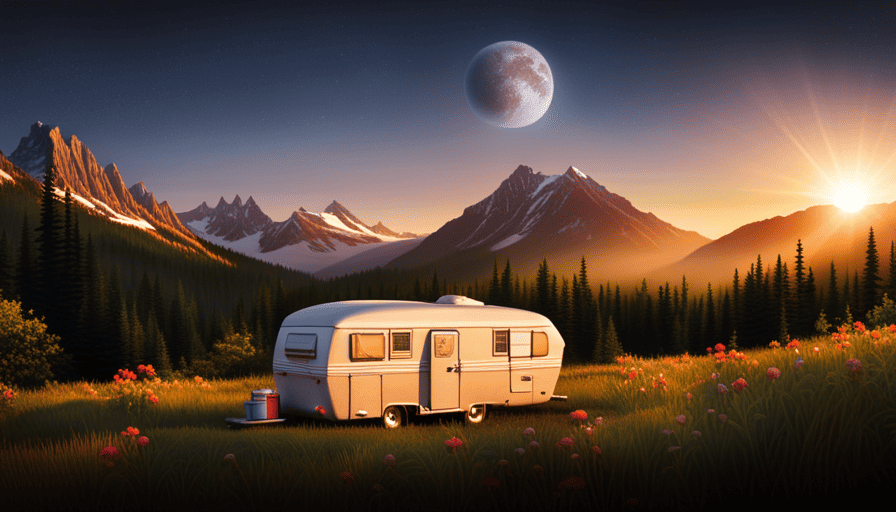Are you prepared to begin an adventure filled with learning and proficiency? Imagine yourself in the wilderness, enveloped by the awe-inspiring splendor of nature. The sun is beaming, birds are chirping, and you’re all set to unwind beneath the shelter of your camper’s awning.
But suddenly, disaster strikes! Your awning is torn or broken, leaving you exposed to the elements. Fear not, fellow adventurer, for I am here to guide you through the process of fixing your camper awning.
In this article, I will share with you the technical know-how and precise steps to bring your awning back to life. From assessing the issue and gathering the necessary tools, to repairing tears and replacing damaged parts, we will leave no stone unturned.
I will also teach you how to lubricate moving parts for smooth operation and adjust the tension and alignment of the awning.
So, grab your toolkit and join me on this journey of restoration. By the end, you’ll be equipped with the knowledge to fix your camper awning and extend its lifespan.
Let’s get started!
Key Takeaways
- Common issues with camper awnings include malfunctioning motors/mechanisms, tears/holes in the fabric, and issues with the awning arms/support brackets.
- Proper installation and choosing the right awning material are essential for avoiding future issues.
- Small tears or holes can be repaired using patching, repair tape, stitching, or reinforcing with glue.
- Damaged or broken parts such as awning fabric or retractable mechanisms may need to be replaced.
Assess the Issue with Your Camper Awning
Now let’s take a closer look at what might be going wrong with your camper awning. When it comes to camper awnings, there are several common issues that can arise. By identifying these issues, you can troubleshoot the problems and get your awning back in working order.
One common issue is a malfunctioning motor or mechanism. If your awning isn’t extending or retracting properly, it could be due to a faulty motor or a problem with the mechanism that controls the movement.
Another issue to watch out for is tears or holes in the fabric. Over time, the fabric can get worn or damaged, leading to leaks or instability.
Additionally, issues with the awning arms or support brackets can cause the awning to sag or become unstable.
To address these problems, gather the necessary tools and materials to fix your camper awning. By having the right tools on hand, such as a screwdriver, wrench, and patch kit, you can quickly and effectively repair any issues that come up.
So let’s move on to the next step: gathering the necessary tools and materials to fix your camper awning.
Gather the Necessary Tools and Materials
First, you’ll need to gather all the tools and materials necessary for the job. To help you with this, I have prepared a table outlining the essential items you will need for fixing your camper awning:
| Tools | Materials | Additional Items |
|---|---|---|
| Screwdriver | Awning Fabric | Ladder |
| Pliers | Awning Roller Tube | Silicone Sealant |
| Adjustable Wrench | Awning Arms | Patch Kit |
| Tape Measure | Awning End Cap | Cleaning Solution |
| Drill | Awning Hardware | Safety Glasses |
Choosing the right awning material is crucial for a successful repair. Consider factors such as durability, weather resistance, and ease of installation. When installing the awning, make sure to follow these tips for proper installation: carefully measure and mark the desired position, secure the awning arms and roller tube tightly, and apply silicone sealant to prevent leaks.
With all the necessary tools and materials gathered, you are now ready to move on to the next step: repairing small tears or holes in your camper awning.
Repair Small Tears or Holes
To mend any minor rips or punctures, simply grab a patch kit and apply it to the affected area, allowing you to restore your beloved outdoor retreat without a hitch.
When it comes to repairing small tears or holes in your camper awning, there are a few patching techniques you can use. Here are some DIY repair methods to consider:
-
Apply a patch: Start by cleaning the damaged area with a mild soap and water solution. Once dry, cut a patch from the repair kit that’s slightly larger than the tear or hole. Apply adhesive to the patch and press it firmly onto the damaged area, ensuring good adhesion.
-
Use a repair tape: If the tear or hole is small, you can use a repair tape specifically designed for awnings. Simply cut the tape to the desired size and apply it over the damaged area, smoothing out any wrinkles or bubbles.
-
Stitch it up: For larger tears or holes, you can use a needle and thread to sew the damaged area back together. Make sure to use a heavy-duty thread and make small, even stitches to ensure a strong repair.
-
Reinforce with glue: If the tear or hole is located along a seam or edge, you can reinforce it with a strong adhesive. Apply the glue to the damaged area and press it together, holding it in place until the adhesive sets.
By following these patching techniques and DIY repair methods, you can easily fix any small tears or holes in your camper awning. Once you’ve completed these repairs, you can move on to replacing any damaged or broken parts.
Replace Damaged or Broken Parts
When replacing any damaged or broken parts, it’s essential to carefully assess the extent of the damage and select high-quality replacements to ensure the longevity and functionality of your outdoor retreat.
One common issue with camper awnings is the fabric tearing or becoming worn over time. To replace the awning fabric, start by removing the old fabric from the awning frame. Next, measure the dimensions of the old fabric to ensure the replacement fabric is the correct size. Attach the new fabric to the frame using heavy-duty adhesive or by sewing it on, following the manufacturer’s instructions.
Another important part to check is the retractable mechanism. If it’s broken or not functioning properly, it’ll need to be replaced. This can be done by removing the old mechanism and installing a new one according to the manufacturer’s guidelines.
Once the damaged or broken parts are replaced, it’s essential to lubricate the moving parts for smooth operation. This will ensure that your camper awning functions properly.
Transition seamlessly into the subsequent section about lubricating moving parts for smooth operation.
Lubricate Moving Parts for Smooth Operation
Ensure the seamless functionality of your outdoor retreat by keeping all the moving parts well-lubricated for a smooth and enjoyable experience. Proper lubrication techniques are essential in maintaining the performance and longevity of your camper awning. Here are some key points to consider:
-
Choose the right lubricant: Use a silicone-based lubricant specifically designed for outdoor use. Avoid using petroleum-based products as they can attract dirt and debris, leading to potential damage.
-
Apply lubricant to the moving parts: Apply the lubricant generously to all the joints, hinges, and pivot points of your camper awning mechanism. Be sure to reach areas that are prone to friction and wear.
-
Regular maintenance: Lubrication should be done at least once a year or whenever you notice any signs of stiffness or resistance when extending or retracting the awning.
By following these lubrication techniques, you can prevent common issues with camper awning mechanisms such as rusting, squeaking, and jamming. Proper lubrication ensures smooth operation and extends the lifespan of your awning.
In the next section, we’ll discuss how to clean and maintain the awning fabric to keep it looking its best.
Clean and Maintain the Awning Fabric
Maintaining a pristine appearance for your outdoor retreat is effortless with regular cleaning and care of the awning fabric, allowing it to remain a vibrant and inviting addition to your outdoor space.
To keep your camper awning fabric in top condition, it’s essential to clean and maintain it properly. Cleaning techniques for awning fabric vary depending on the material, but generally, a gentle approach is recommended to avoid damaging the fabric.
Start by brushing off any loose dirt and debris using a soft-bristle brush. Then, mix a mild detergent with warm water and apply it to the fabric using a sponge or soft cloth. Gently scrub the surface in a circular motion, paying special attention to any stubborn stains. Rinse thoroughly with clean water and allow the fabric to air dry completely before retracting the awning.
When it comes to cleaning products, it’s important to choose ones that are specifically designed for awning fabrics. Look for products that are gentle and non-abrasive to ensure the longevity of your awning fabric. Avoid using harsh chemicals or bleach, as they can cause discoloration or damage to the fabric. Additionally, always follow the manufacturer’s instructions for cleaning and maintenance.
With your awning fabric clean and maintained, the next step is to adjust the tension and alignment of the awning to ensure smooth operation.
Adjust the Tension and Alignment of the Awning
To ensure the longevity and functionality of your camper awning, it is essential to adjust its tension and alignment periodically. This will prevent common issues such as sagging or misalignment, which can compromise its performance. Adjusting the tension and alignment of the awning is a relatively simple process that can be done with just a few tools.
First, locate the tensioning knobs or screws on the awning arms. These are usually found near the joints or on the main support bracket. Using a wrench or screwdriver, loosen the knobs or screws to allow for adjustment.
Next, refer to the manufacturer’s instructions for specific adjustment techniques. Some awnings may require turning the knobs clockwise or counterclockwise, while others may require tightening or loosening the screws.
To help you understand the process better, here is a helpful table:
| Adjustment Technique | Clockwise | Counterclockwise |
|---|---|---|
| Tensioning | Tighten | Loosen |
| Alignment | Right | Left |
Once you have made the necessary adjustments, tighten the tensioning knobs or screws to secure the awning in place. Finally, test the awning for functionality to ensure that it opens and closes smoothly.
Transition: Now that the tension and alignment of the awning have been adjusted, it’s time to test its functionality to ensure it is working properly.
Test the Awning for Functionality
Now, let’s see if your awning is working properly by testing its functionality. Here are some testing techniques and troubleshooting tips to ensure everything is in order:
-
Observe the extension and retraction: Activate the awning to check if it extends and retracts smoothly. Watch for any jerking or sticking movements that could indicate a problem with the motor or mechanism.
-
Inspect the fabric and frame: Carefully examine the awning fabric for any tears, rips, or signs of wear. Check the frame for any bent or damaged components that may affect the awning’s functionality.
-
Test the wind sensor (if applicable): If your awning has a wind sensor, simulate windy conditions by gently blowing air towards it. Ensure that the sensor triggers the automatic retraction function as expected.
By following these testing techniques and troubleshooting tips, you can identify any issues with your camper awning and address them promptly.
Now, let’s move on to preventive measures to extend the lifespan of your awning by implementing regular maintenance and care.
Preventive Measures to Extend the Lifespan of Your Awning
After testing the functionality of your camper awning, it’s important to take preventive measures to extend its lifespan. Preventing damage is crucial to avoid costly repairs or replacement.
One of the key factors in maintaining your awning is choosing the right fabric. Opt for a high-quality material that’s durable, weather-resistant, and easy to clean. Look for fabrics that are specifically designed for outdoor use, as they’re more likely to withstand the elements and resist fading.
Regularly inspect your awning for any signs of wear and tear, such as fraying or loose stitching. Address any issues promptly to prevent further damage.
Additionally, keep your awning clean by regularly removing dirt, debris, and leaves. This will prevent stains and the buildup of moisture, which can lead to mold or mildew.
Consider using awning accessories like wind sensors or tie-downs to protect your awning during inclement weather. These additions can help prevent damage caused by strong winds or heavy rain.
By following these preventive measures, you can significantly extend the lifespan of your camper awning and avoid unnecessary repairs. However, if you encounter any complex issues or are unsure about the necessary steps to take, it’s always advisable to seek professional help.
Seek Professional Help if Needed
If you find yourself in a bind with your camper awning, don’t hesitate to seek professional assistance for expert guidance and solutions. While some minor repairs can be done on your own, it’s important to know when to DIY and when to hire a professional. Here are some tips for finding a reliable camper awning repair service:
-
Research: Start by researching different repair services in your area. Look for companies that specialize in camper awning repairs and have positive customer reviews.
-
Experience and Expertise: Choose a repair service that has years of experience in fixing camper awnings. A knowledgeable technician will be able to diagnose the problem accurately and provide the right solution.
-
Warranty: Check if the repair service offers a warranty on their work. A reliable company will stand behind their repairs and offer a guarantee on the quality of their service.
-
Price: Get quotes from different repair services and compare their prices. Keep in mind that the cheapest option may not always be the best. Look for a balance between quality and affordability.
-
Recommendations: Ask friends, family, or fellow campers for recommendations. Personal referrals can help you find a trustworthy repair service.
By following these tips, you can find a reliable camper awning repair service that can help you fix any issues with your awning.
Frequently Asked Questions
How do I know if my camper awning needs to be repaired or replaced?
If you notice signs of wear and tear on your camper awning fabric, it may be time to consider repairs or a replacement. Look for fraying, holes, or fading color as indicators.
To properly maintain your camper awning, regularly clean it with a mild detergent and water, and avoid using abrasive cleaners or brushes. Additionally, make sure to retract the awning during inclement weather to prevent damage.
Can I use regular household tools to fix my camper awning, or do I need specialized tools?
When it comes to fixing a camper awning, using regular household tools can be a viable option, but it also has its limitations. Household tools are easily accessible and can handle basic repairs, but they may not be suitable for more complex issues. Specialized tools, on the other hand, are specifically designed for awning repairs and can ensure a more precise and efficient fix. However, if you’re looking for alternative solutions or DIY hacks, there are various resources available online that provide step-by-step instructions using common household items.
Are there any specific cleaning products I should use to clean my camper awning fabric?
When it comes to cleaning camper awning fabric, it’s important to use the right cleaning products and methods. To ensure the best results, I recommend using specialized cleaning products specifically designed for awning fabric. These products are formulated to effectively remove dirt, stains, and mildew without causing damage.
It’s important to follow the instructions provided by the manufacturer of the cleaning product for the best cleaning methods and to maintain the longevity of your camper awning fabric.
How often should I adjust the tension and alignment of my camper awning?
Adjusting the tension and alignment of your camper awning is crucial for its optimal performance. Just like a finely tuned instrument, regular maintenance ensures smooth operation.
To keep things running smoothly, lubricate the moving parts of your awning at least once a year using a silicone-based lubricant.
When it comes to storing your awning during the off-season, ensure it’s clean and dry before rolling it up. Proper storage prevents damage and extends its lifespan.
What are some common signs that my camper awning is not functioning properly and needs to be tested for functionality?
Signs of awning malfunction can include difficulty in extending or retracting the awning, sagging or uneven fabric, and excessive noise during operation. To test the functionality of a camper awning, start by inspecting the hardware for any signs of damage or wear.
Then, operate the awning multiple times to ensure it extends and retracts smoothly. Finally, check the tension and alignment to ensure the fabric is properly supported and aligned.
Can the Same Techniques Be Used to Fix a Pop Up Camper Lift System and a Camper Awning?
Fixing a pop up camper lift system and a camper awning may require different techniques, as they serve different purposes. While the lift system involves repairing components such as cables and pulleys, the awning often requires troubleshooting issues with its fabric or motorized mechanisms. Despite distinct challenges, both tasks can be accomplished with proper knowledge and expertise in fixing pop up camper lift systems and camper awnings.
Conclusion
In conclusion, fixing a camper awning requires a careful assessment of the issue and gathering the necessary tools and materials.
Small tears or holes can be repaired easily, while damaged or broken parts may need to be replaced.
Lubricating moving parts ensures smooth operation, and adjusting tension and alignment is crucial for proper functioning.
Testing the awning for functionality is essential before hitting the road.
To extend the lifespan of your awning, preventive measures should be taken.
And if all else fails, don’t hesitate to seek professional help.
Coincidentally, following these steps will have your awning looking brand new in no time!











